"Then a promontory rises in the sea in the shape of a great horn; by some it is called Artabrum1, by others the Great promontory, while many call it 'the promontory of Olisipo', after the city that lies nearby. This place forms a dividing line between the land, the sea and the sky".2
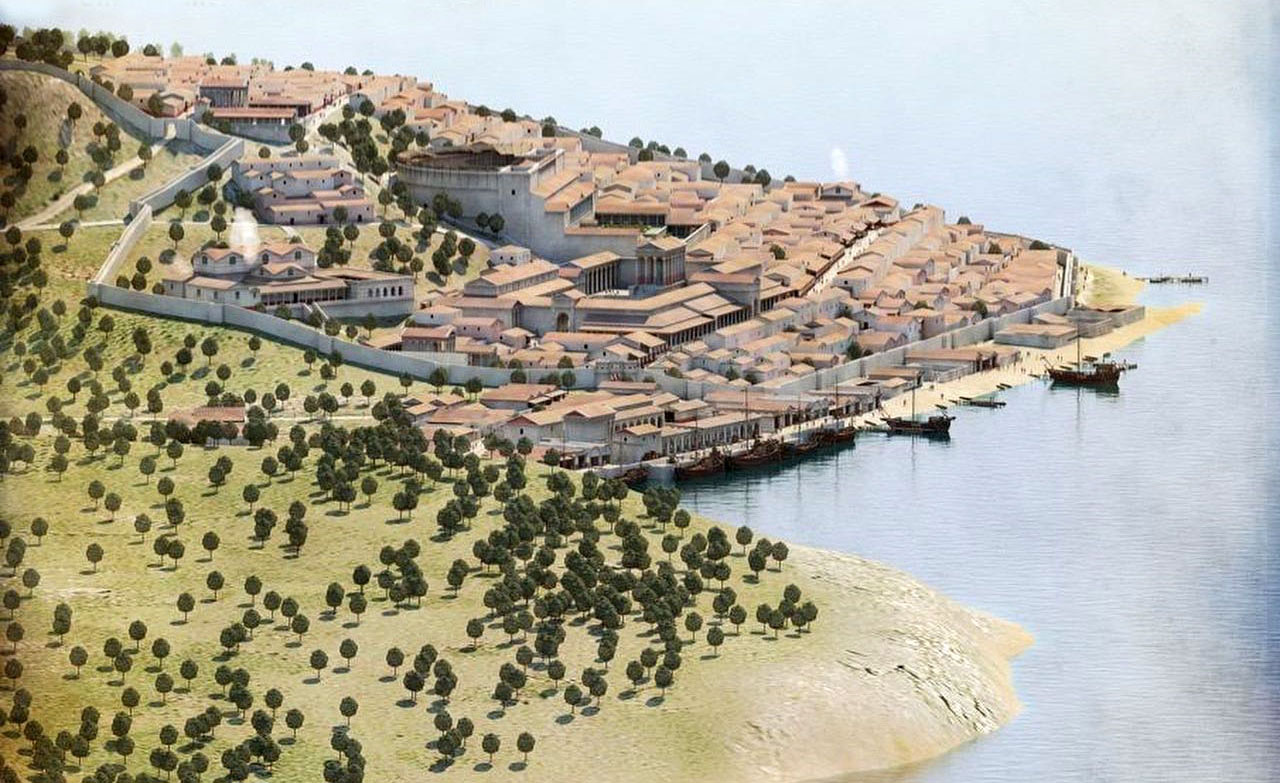
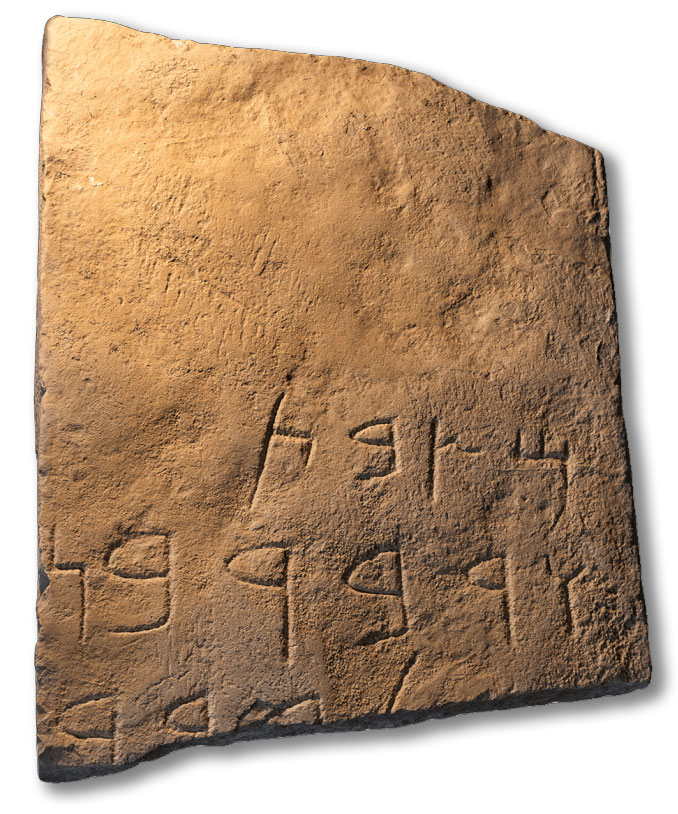
According to a Greek legend, present-day Lisbon, lying on the Tagus river, was founded by Odysseus during his 20-year wandering across the Mediterranean and the Atlantic. He is said to have named the city Ulisipo or Ulisseya. The Romans gave it the name Olisipo.
This vernacular etymology was narrated by the Greek historian Strabo3 based on tales of Asclepiades of Myrleia, another Greek historian from the second century BC.
What we do know for sure is that the Phoenician civilisation had penetrated these regions early on. They also introduced writing here as evidenced by graffiti on an amphora from the 7th century BC and a grave inscription of a local. The Phoenicians maintained important trade relations with western Europe5.
Mining in the Tagus estuary was of great importance to the eastern population which must have made Olisipo in particular very much of interest to the Phoenicians. Pliny the Elder, in his work Naturalis Historia, mentions the presence of carbunculus (a word expressing the colour similarity between garnet and fire) in the territory of Olisipo, more precisely in Mount Suimo, a small round hill and highest point in Carreguera, located between Lisbon and Sintra.

To illustrate this reference, the author used texts by Cornelius Bocchus, a Roman who lived in Salacia (Alcácer do Sal) and wrote about the riches of Lusitania around 49 AD. He described garnet mining as a costly activity.
The fall in 573 BC of Tyre6, the main Phoenician city at the time, led to a drastic reduction in trade between the eastern and western Mediterranean, forcing the western colonies to seek their economic activities elsewhere.
The economy of the estuary7 and a communication gateway with the hinterland
"The Tagus estuary has a length of twenty stadia (about 3.7 km) and a great depth, so that it can be navigated by cargo ships with a capacity for ten thousand amphorae. When the tide is high, it even forms two estuaries in the inland plains, so that it extends like a navigable sea over one hundred and fifty stages (approx. 27.75 km). In the upper estuary, there is a small, fertile island equipped with beautiful vineyards with a length of about thirty stages (about 5.5 km) and a width slightly less than its length. Around the island it is easy to navigate and the river itself is rich in fish and oysters." .8
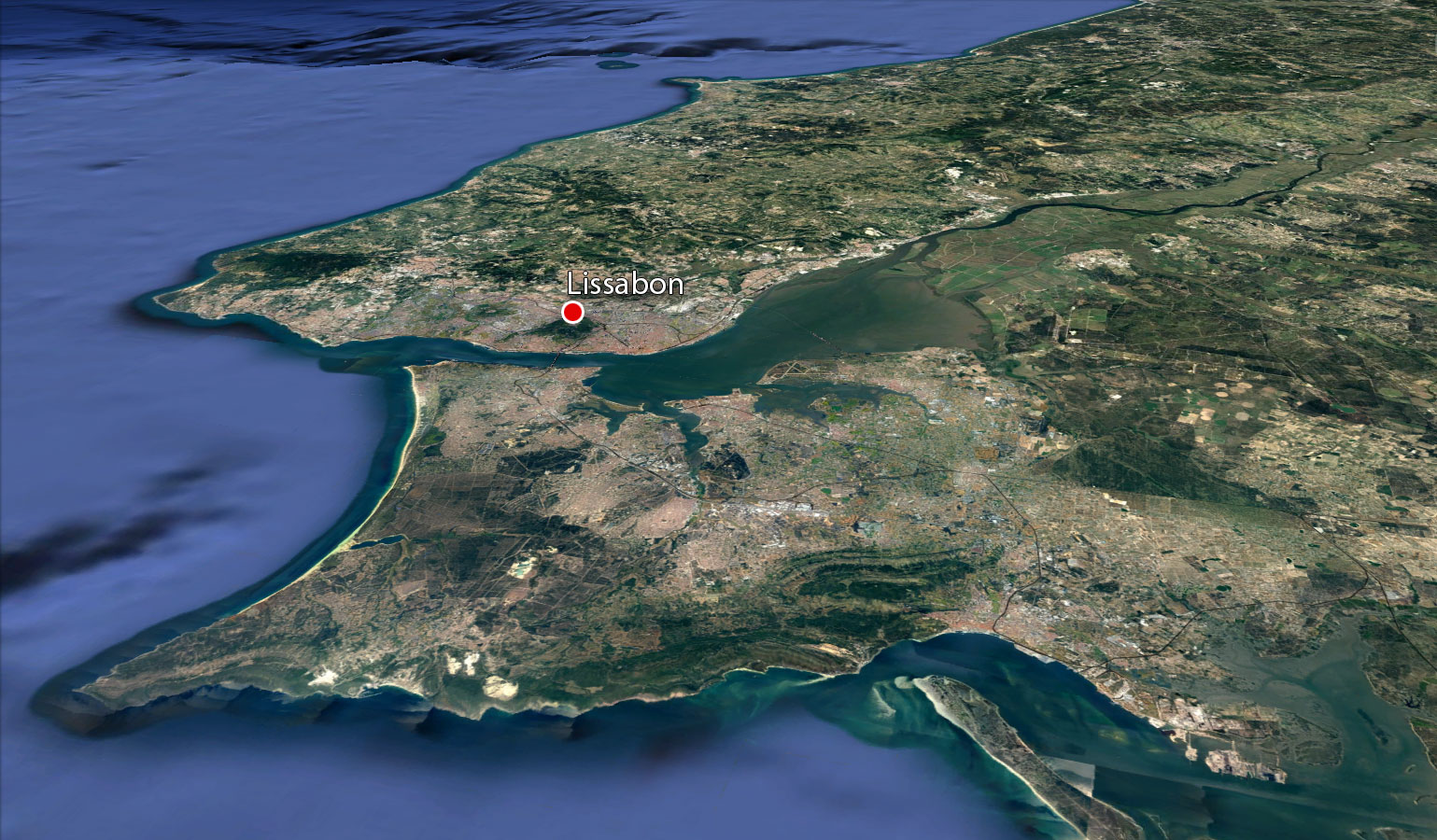
This description of the mouth of the Tagus, described by Strabo around the beginning of our era, already mentions some of Olisipo's characteristics that have since been proven by archaeological research, namely fish richness, presence of beautiful vineyards and the ease of inland navigation, even for boats with a large draft. All these and other factors, ensured the wealth and prosperity of Olisipo. It was not for nothing that the Romans chose this city as the main port of the westernmost province of their empire. A place where Mediterranean and Atlantic influences converged.
We see how Oceanus (Atlantic Ocean), for the Romans, became increasingly important, especially after the establishment of the north-western border of the Empire, the area of present-day Holland and Germany (Germania Inferior), and the conquest and integration of Britain, under the Emperor Claudius.
A port between the Atlantic and the Mediterranean
"I controlled the provinces of Gaul and Hispania, as well as Germania, including the Ocean, from Cadiz to the mouth of the Elbe [...]
My fleet sailed across the Ocean from the mouth of the Rhine eastward to the Cimbrian coasts (Jutland peninsula, present-day Denmark), an area that no Roman had reached before, either by land or sea.". 9
In the autopanegyric10 Augustus, the first Roman emperor, had composed as a political testament, named "The deeds of the divine Augustus", the triumph over the ocean is presented as one of the achievements, among several others, of which the Princeps (first or principal person) was very proud. The triumph over the great sea was particularly important because it represented the effective domination of the boundaries and the annexation of a remote and obscure territory. The whole of this extended Atlantic front became Roman. The places alongside that front could serve as support for navigation to all those other places.
Pliny the Elder, who also echoed Augustus' prowess11 recounts a curious incident that occurred in the time of Tiberius, when an envoy from Olisipo visited the emperor to tell him about the tritons and nereids12 that were said to have been seen along the coasts of the ocean13. The story of the wonders of this coastal area, would have been the motto of the visit, but it seems more credible to assume that other interests related to the sea, shipping and navigation were also involved in the meeting. Archaeological finds have shown that at that very time, the city of Olisipo was building on its embankment.
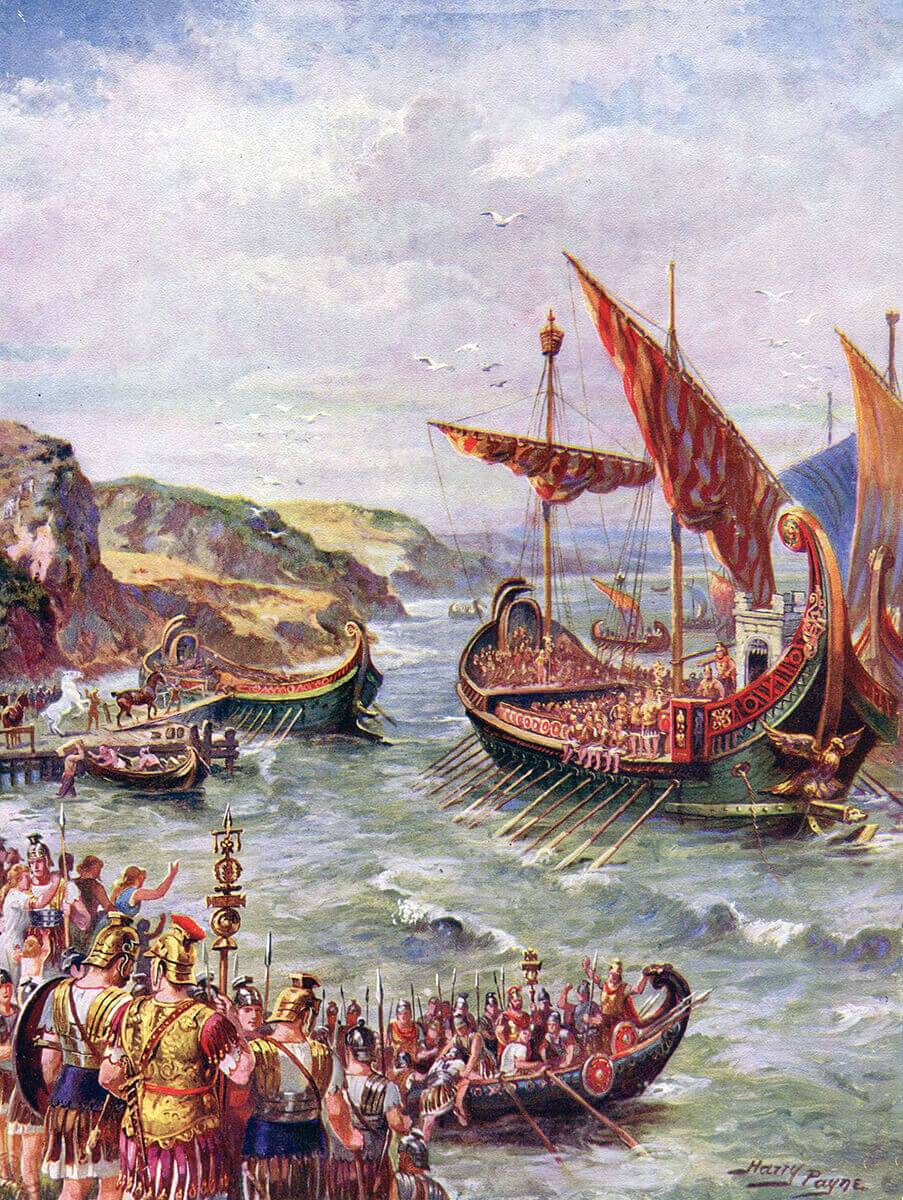
In 43 AD, during Claudius' conquest of Britannia, there was an incident that would demonstrate the need for Atlantic coastal towns.
The Roman historian Tacitus14, who did not usually speak sympathetically of Claudius, wrote on the subject that the emperor tried to make his way to Britannia twice over sea, but both attempts encountered storms that almost endangered his life, so he continued his expedition overland as far as Gesoriacum (Bologne-sur-mer), and there they crossed the English Channel. Once back, during his triumphal procession, he is said to have added a naval crown to his civilian crown, as proof that he had conquered the Ocean16.
After the conquest of Britannia, Rome established an ample number of militarised zones along the North Atlantic seaboard, which needed regular supplies. Here, the Atlantic front of the Iberian peninsula was particularly important which is confirmed, among other things, by the presence of lighthouses, the most expressive example being the lighthouse of A Coruña (in northern Galicia), intended for navigation. Because it was unthinkable in ancient times to cross the Ocean directly, support points and stopovers, including Felicitas Ivlia Olisipo, as the Romans called the city in full, were particularly important.
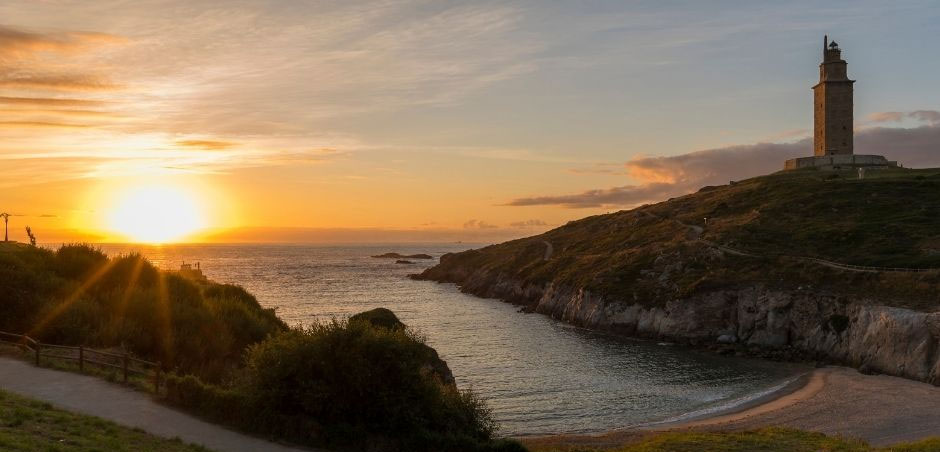
The harbour of Olisipo
Unfortunately, for various reasons, it is not possible to identify the harbour structures of the city of Olisipo. However, remains and a cryptoporticus of a large public bathhouse complex that stood in the port area in ancient times have been found.
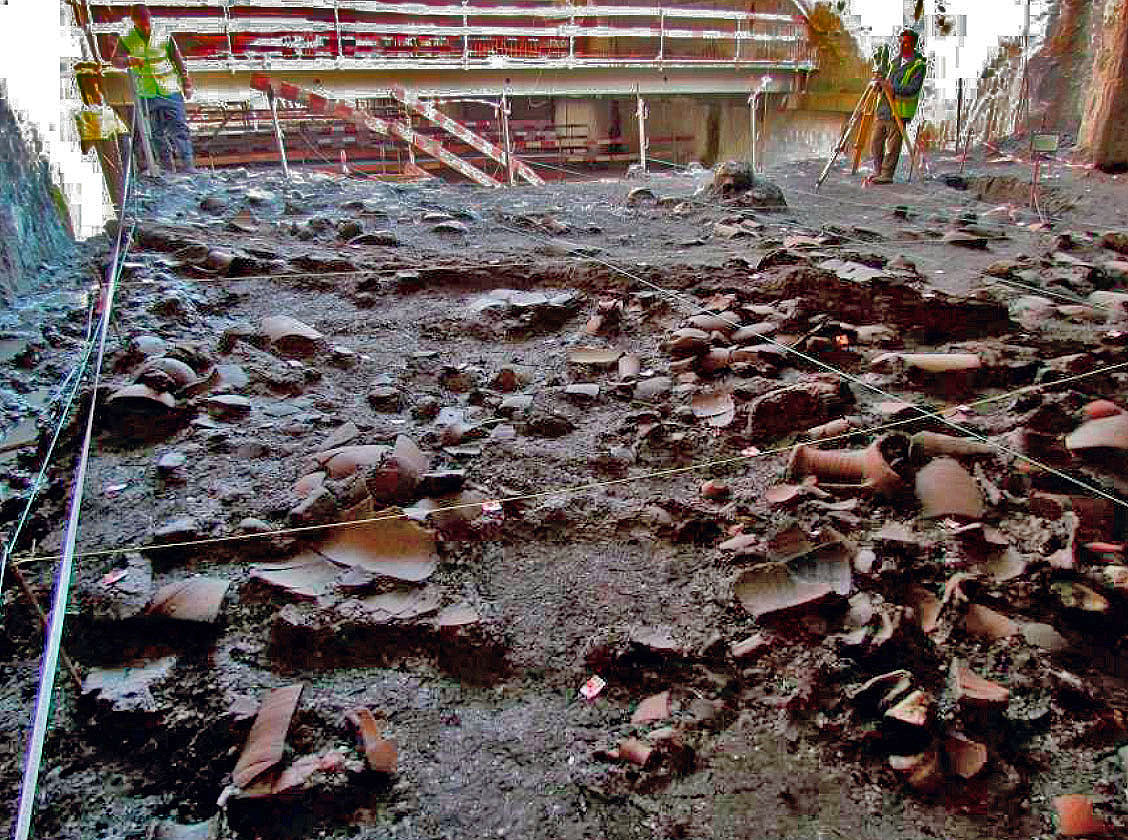
But even without harbour structures, jetties and quays, the maritime activities of the past can be demonstrated. For example, accumulations of rubble have been found in and around some parts of the ancient river course18. Typical 'harbour debris' consisting of elements that had accidentally fallen from ships and not been recovered or things that had been thrown into the river on purpose. Those finds were made, among others, in today's Praça D. Luiz, Avenida da Ribeira das Naus and Praça do Município where once the old riverbed near the shore must have been. The ceramics found there came from different regions of the Roman Empire, although some included local pottery. The features allow us to conclude that 'the material was in transit', from departure or arrival, and were lost during loading or unloading or resulted from deliberate throwing into the river, for religious reasons or as thanksgiving for the success of the journey.
All over the city, excavations have found abundant traces of the most diverse items imported from near or far regions, which are evidence of the intense circulation of merchandise that makes Olisipo one of the most lively meeting places of products and people from the remotest places.
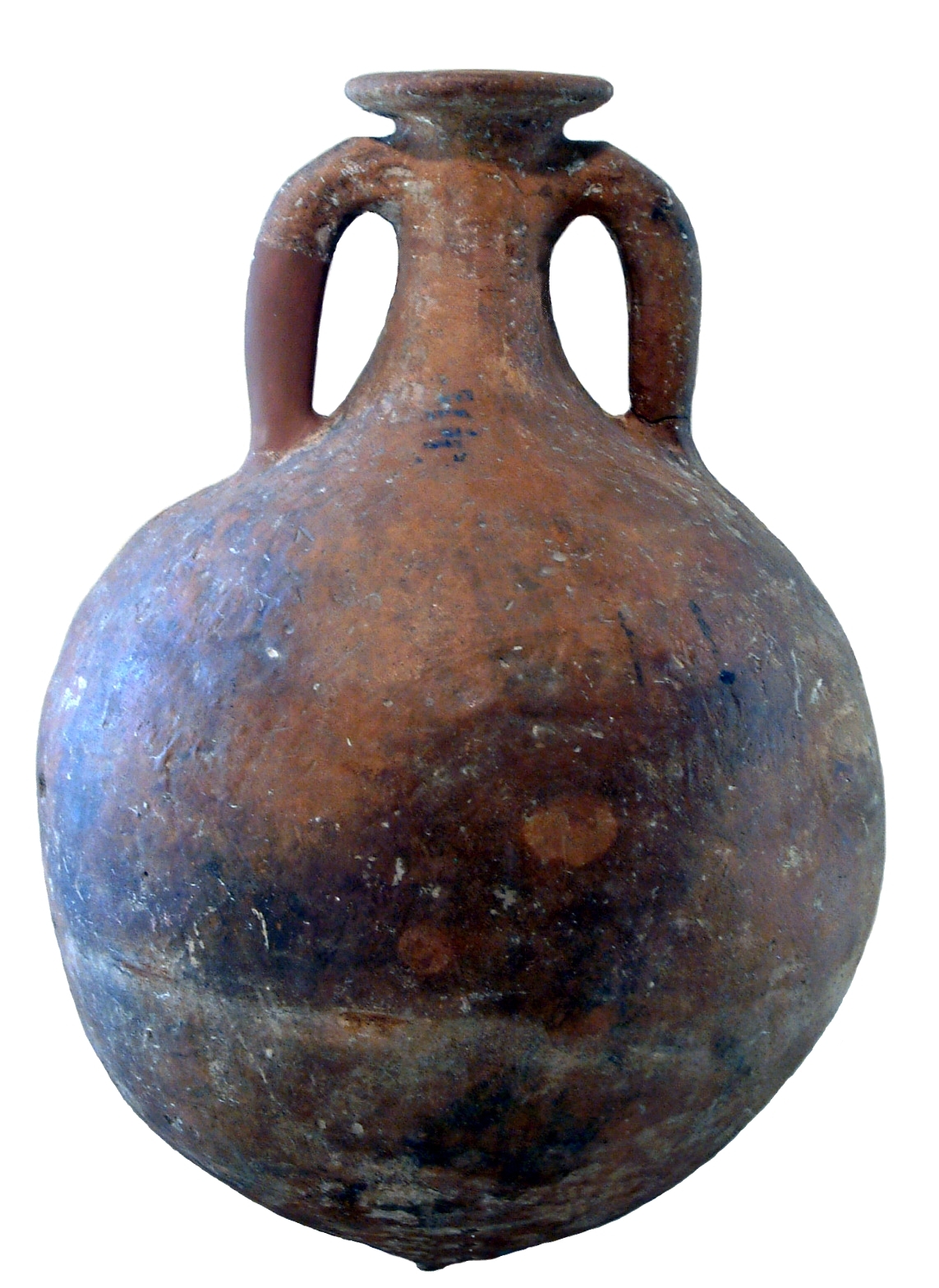
For example olive oil from the province of Bética (now Andalucia), which was transported to the northern parts of the Roman Empire in heavy spherical Dressel 20 amphorae. The reason for this flow of goods was partly due to the lack of olive oil in those regions and the many uses of olive oil in antiquity (food, fuel, hygiene and medicinal use). The official distribution of olive oil was promoted by the state.
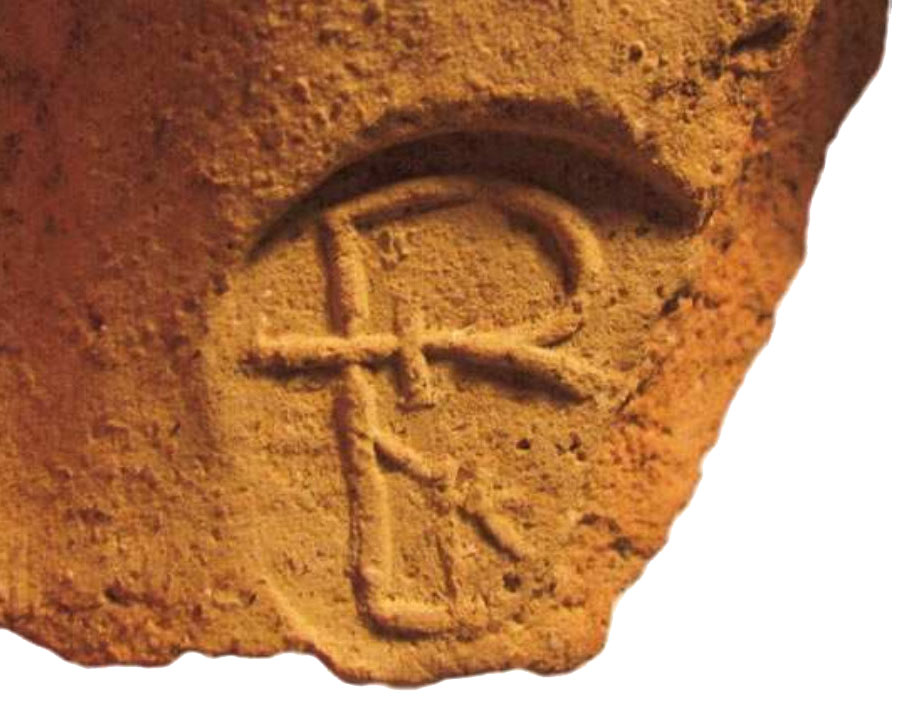
These amphorae have the particularity of often bearing printed production marks. Several of these amphorae have been found in the town of Olisipo and also in other places in present-day Andalusia.
Recent study has shown that many of these marks are also present at archaeological sites in todays Britain and in the former province of Lower Germany, providing a credible indicator of the use of the sea route through the Tagus estuary to the north.
However, amphorae have also been found in Olisipo that are very little represented elsewhere, suggesting that they are small productions with a more limited circulation. One can then also conclude that the port of Olisipo was in fact a transit port and fulcrum for the large shipping of institutional transports, but also gave a space to smaller shipping areas, related to small cabotage shipping21, in a free market environment.
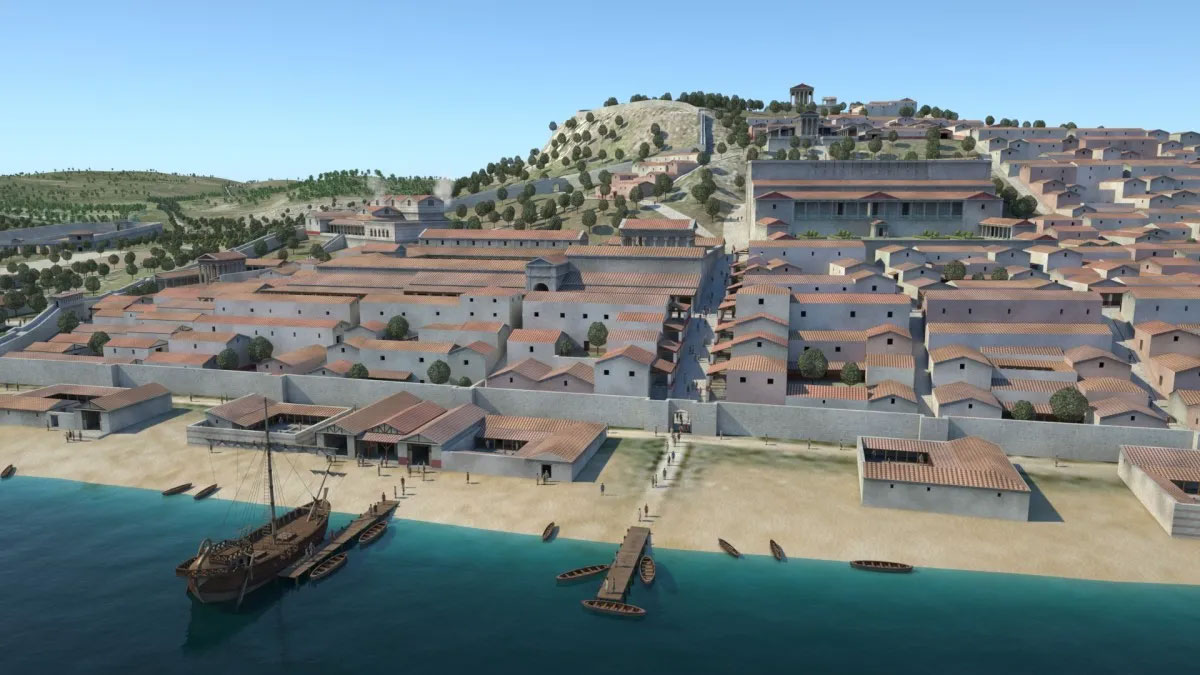
We have no iconographic representation of the port of Olisipo, but we can assume that it will not have been much different from other Roman river ports with the same large and small type of ships docked or anchored off the city. Olisipo was the communication centre between the Roman province of Lusitania and the Empire. Both in terms of imports, transit of external products and exports of products from Lusitania.
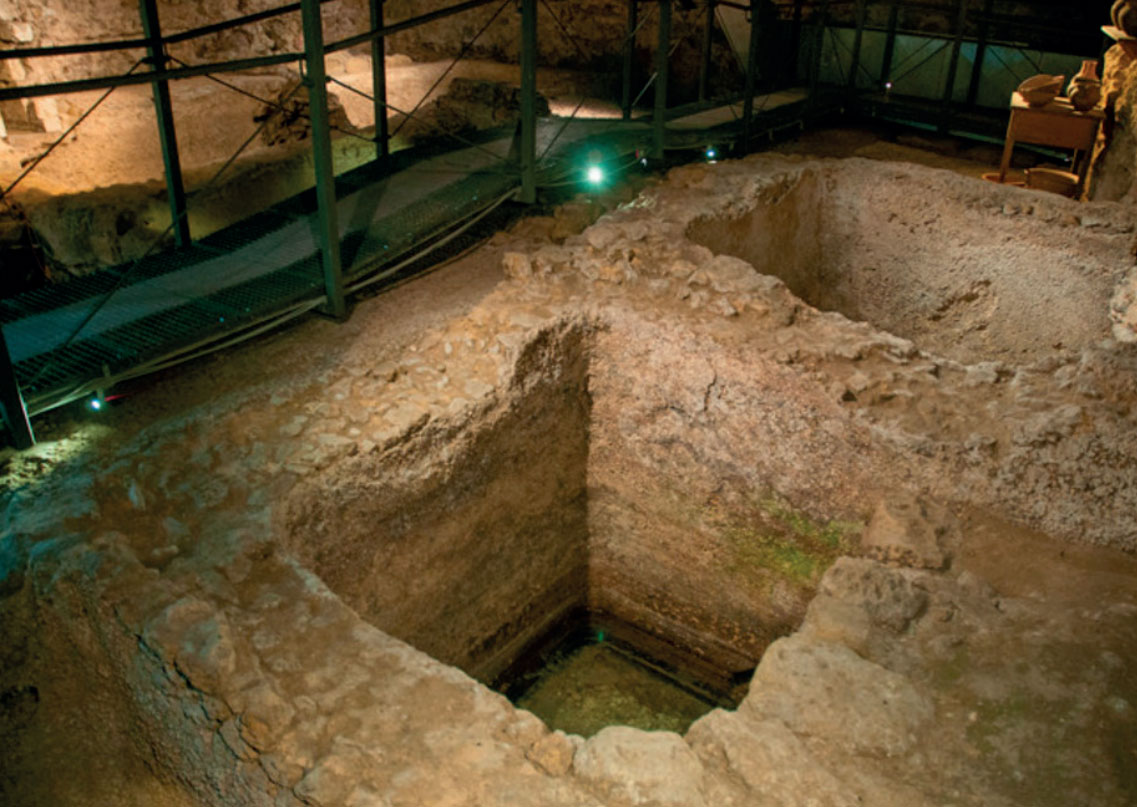
Everywhere in the current city centre and river area, we find buildings with cetariae (large tanks) intended for fish preparation production.
Judging from the immense capacity of all those cetariae we can certainly say that it was far too large for local needs only and that the products were therefore destined for export. The finished product was transported in amphorae made in potteries on the left bank of the Tagus estuary, near the river.
Using this data, let us see what it tells us about the economy of the Tagus estuary.
The existence of an extensive fishing industry in Felicitas Ivlia Olisipo may certainly assume the presence of a fishing fleet, which fed production. This also implies the possibility of the existence of shipbuilding and ship repair, even if only of small boats, as well as manufacture of nets and other fishing supplies.
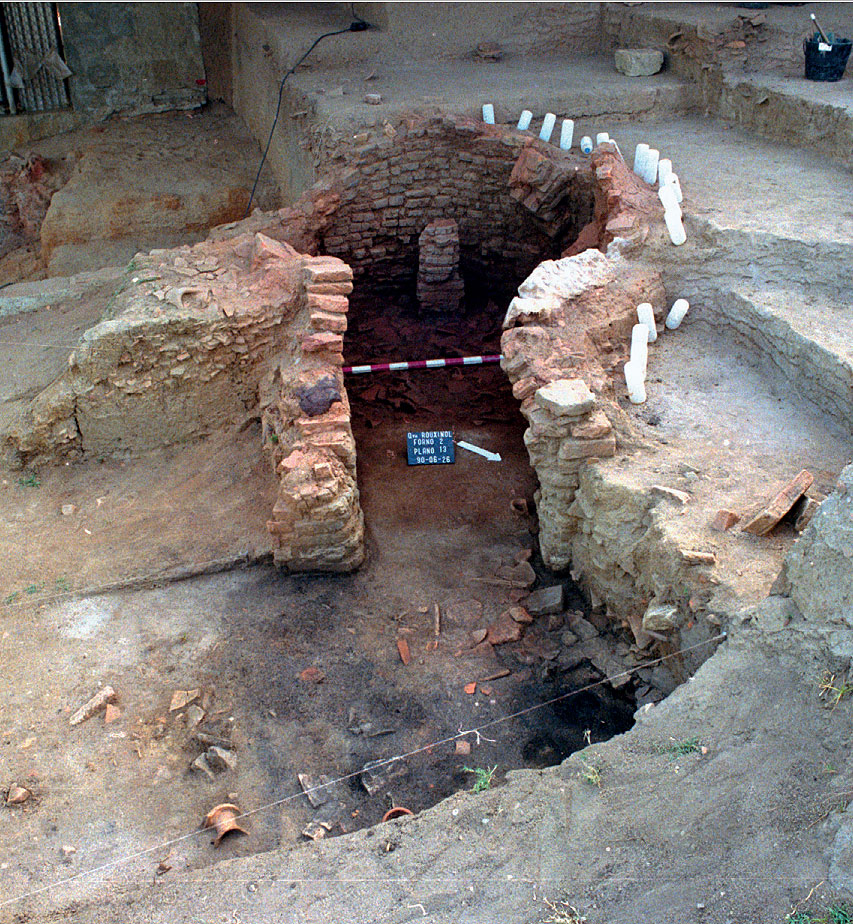
Fish preparation also undoubtedly required production of sea salt obtained by evaporation in salt pans.
In addition to the production of oil, which was used to transport the final product, amphorae were needed, which in turn had to be made. These amphorae were not only for fish products but also for transporting wine, which was widely exported, especially from the second century AD. In other words, a series of complementary activities spread across the estuary, which had the city as its central core.
The wide distribution of Lusitan amphorae (not all from the Tagus estuary), shows how the navigational possibilities, upstream and by sea, were widely used. This was complemented by a network of roads that established communication with various centres inland, notably the provincial capital Augusta Emerita (present-day city of Mérida, Spain), which saw Olisipo as its main seaport. We can say that most of the exotic goods found in the provincial capital came from Olisipo.
On the other hand, Pliny the elder praised the famous olives from Merida24, which were exported to other parts of the empire through the port of Olisipo. It was thus a two-way movement between the port of Olisipo and the provincial capital. This city was not only a recipient but also an exporter, and olives are just one example.
Felicitas Iulia Olisipo in Roman times

So, what exactly the port facilities of Olisipo looked like we do not know and where they were located exactly is also difficult to say. The same was true of the town itself. Until the 18th century, people knew the name and location of Felicitas Ivlia Olisipo only from ancient writings and an occasional epigraph. Apart from the identification of a piece of dam and one of the Roman aqueducts, no material remains of the Roman city were known. What the city looked like in ancient times, where its boundaries were, is still difficult to say to this day.
No ancient description of Felicitas Iulia Olisipo is known either. However, through written sources, we do know a little more about the history of the region and the city at the time of the Romans.
With the foundation of the Roman republic in 509 BC, the Roman monarchy comes to an end and the Res Publica25 (cause of the people). begins. A new political and social concept is introduced in which all Roman citizens share rights and duties, as expressed in the phrase Senatus Populusque Romanus (The Roman Senate and the People), which can be read to this day, with the abbreviation SPQR on all public facilities in modern Rome, such as manhole covers.
This period, which ends in 27 BC with the reign of Octavian, as the first emperor, witnessed, among other things, the establishment of magistracies and assemblies (including the Senate), of a constitution, the army and the territorial expansion that would later reach present-day Portugal.
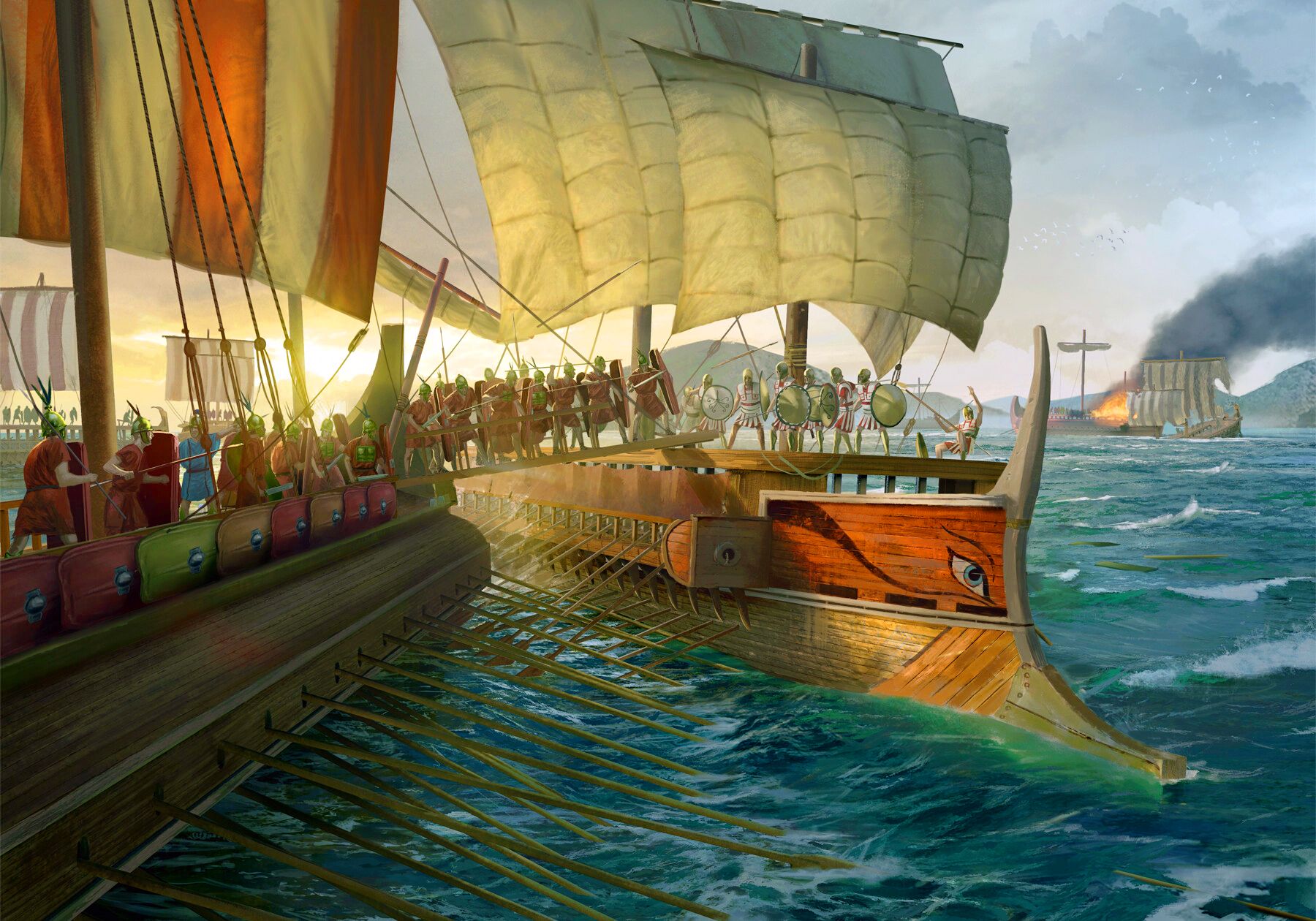
Between 264 and 146 BC, three wars raged between the two major economic powers in the Mediterranean, the Phoenicians and the Romans. These wars became known as the Punic Wars (the Romans called the Phoenicians 'Punians').
In the aftermath of the Second Punic War (218 - 201 BC), famous for the mythical crossing of the Alps by the Punic general Hannibal Barca, Rome controlled the Iberian Peninsula, which until then had been under the Phoenicians' sphere of commerce. After this long military episode, Rome became the dominant power in the Mediterranean, followed by territorial conquests in the Iberian Peninsula.
In 138 BC, the first Roman military contingent arrived at the mouth of the Tagus River. The consul and new governor of this part of Hispania, Decimus Junius Brutus Callaicus, immediately started fortifying Olisipo. The city probably served as a support point to supply the legions on campaign in the interior of the territory.
Between 32 and 27 BC, the Emperor Augustus granted Olisipo the status of a Roman municipality, Municipium Civium Romanorum, along with the name addition Felicitas Iulia.
Rediscovery of the ancient city
It was the great destruction caused by the 1755 earthquake and, above all, the immense effort of reconstructing the city that brought to light some of the most remarkable public buildings from ancient Olisipo. Incidentally, these were not the first buildings to be recovered. During construction activities in Magdalena Square, earlier in the 18th century, a cryptoporticus, a large Roman complex with a row of columns, was discovered. Originally it was thought to be a temple dedicated to Magna Mater (Great Mother)27, due to the presence of two epigraphs for this goddess.
The fact that so few remains from antiquity have apparently been preserved is probably related to the many earthquakes that hit the city. Apart from the one of 1755, there were quakes in 1321, 1356, 1531 and there will also have been several in antiquity. The combination of the devastation caused by these earthquakes and the ongoing construction and reconstruction of the city, might well be a reasonable explanation for the failure to preserve remains of the Roman city.
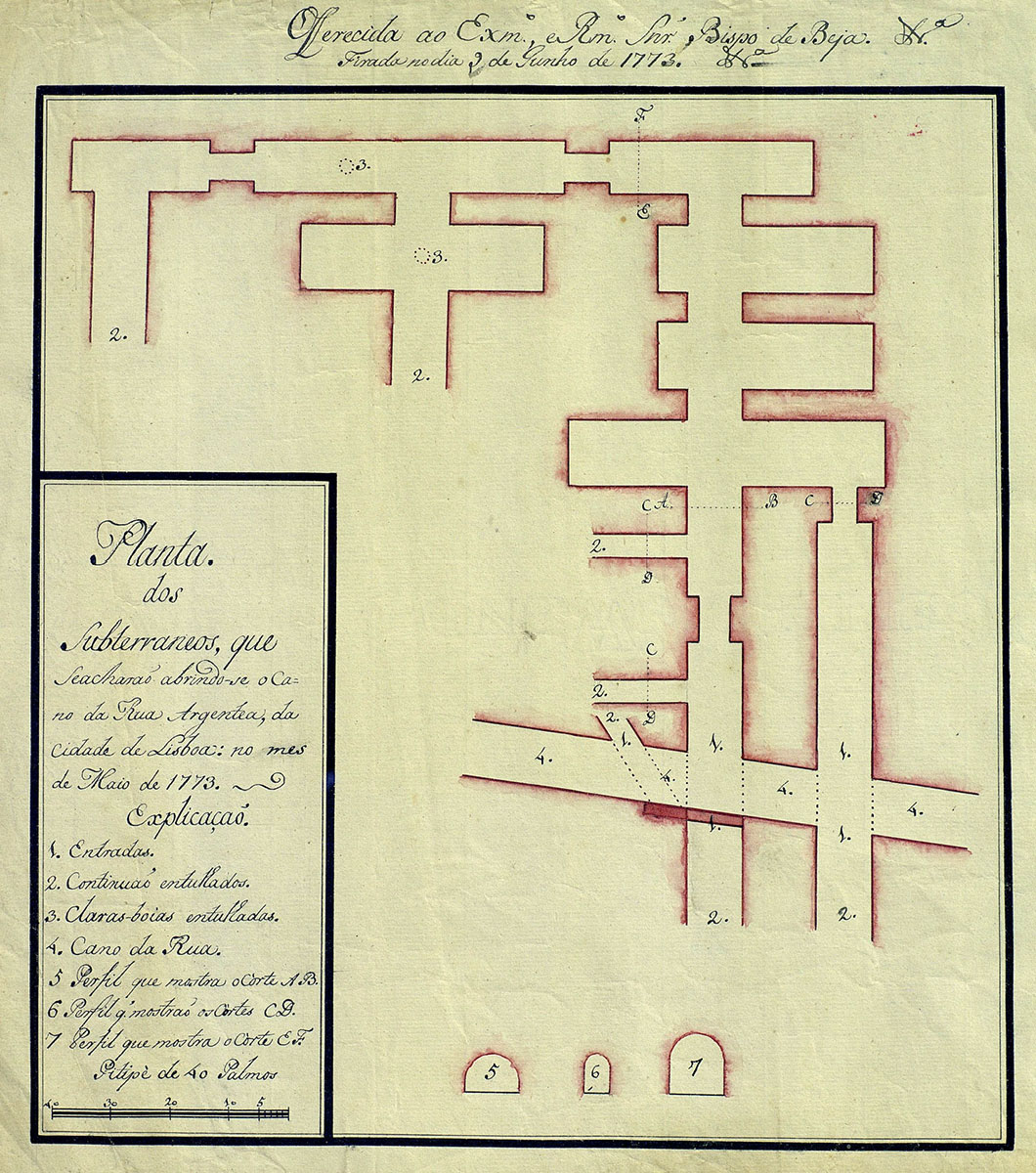
Perhaps this was also the reason why there had been little or no interest in the city's ancient history in previous centuries. However, as with the excavations in the cities buried by the eruption of Vesuvius (Herculaneum and Pompeii), renewed attention to the material remains of the classical past emerged in Lisbon after the first discovery too.
In 1770, the remains of the aforementioned cryptoporticus were the first to be described and recorded on a drawing two years later. They were relatively well preserved below the city and it was absolutely clear that it was a substructure of a public building. It was even suggested that it could be a kind of "corporate forum" built next to the port 29. The complex was also suggested to be either the catacombs of Olisipo or part of a thermal building, an interpretation prompted by the location of an epigraph dedicated to Aesculapius 30 and by the mistaken belief that it belonged to the Thermae Cassiorum, a bathhouse located far enough away from it to have any relation to this complex as was revealed when the latter bathhouse was excavated in 1772.
The real Thermae Cassiorum was identified by an inscription in the wall as well as a reference to a conversion in AD 336.
In recent years, further work has been carried out on the cryptoporticus site and it is currently widely believed that it can be considered as the substructure of another large public thermal complex, the 'city's harbour bathhouse'.

The theatre
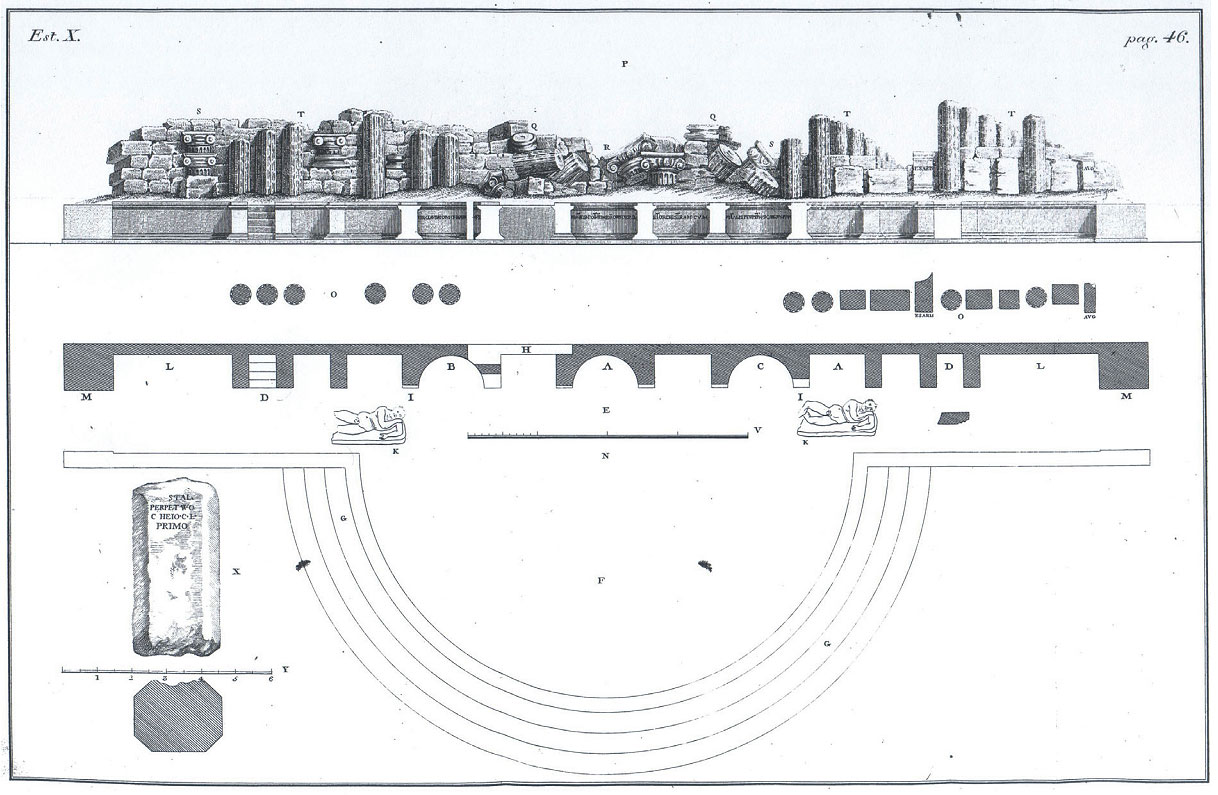
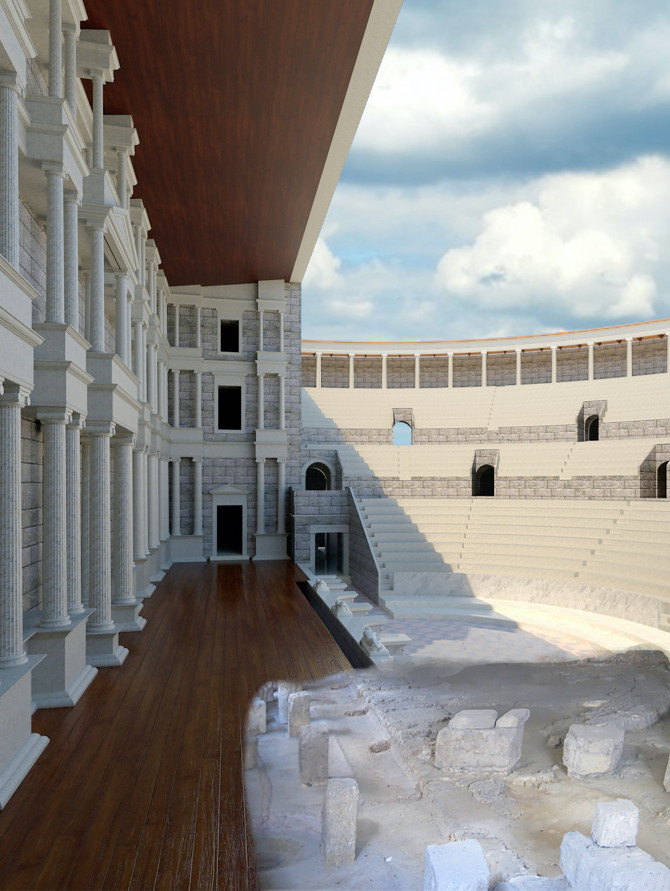
The most relevant building identified was undoubtedly the theatre. It was uncovered in 1798, during the reconstruction of the city of Lisbon, after which the architect Manoël Caetano de Sousa drew an initial schematic plan of it.
The theatre of Felicitas Iulia Olisipo served not only for the entertainment of the population but also as the main purveyor of imperial propaganda. It was renewed in 57 AD, which is recorded in the monumental epigraphic inscription engraved in the proscenium (wall demarcating the stage). According to the epigraph, the rebuilding consisted of improving the proscenium and the orchestra (semicircle in front of the stage) where prominent figures were seated and where the choir sang. The rebuilding was sponsored by Caius Heius Primus, a wealthy freedman, who had possibly become rich in trade.
Regretfully, it seems that the need to build a new city as soon as possible after the earthquake meant that the remains of the ancient city were doomed to be dismantled and demolished.
However, an Italian architect, Francisco Fabri, studied at the Academy of Bologna and imbued with a new culture of appreciation for classical heritage, promoted the continuation of the excavations of the theatre and the study of its remains. Unfortunately, the first decades of the 19th century were not particularly conducive to any attention to the material legacy of the past. The Portuguese court fled from Napoleon to Brazil, the monument fell into oblivion and the city grew over its ruins. Only in the second half of the 20th century the Roman building was re-excavated albeit in much worse conditions than when it was discovered the first time.
Thus, some major buildings were eventually rediscovered and fortunately partially preserved. What is missing, however, is information on domestic architecture of the locals with mosaics and painted stucco, the normal urban building.
It is also very strange that there is no reference to cetariae, intended for the preparation of fish products, which have been found abundantly in the archaeological excavations carried out in recent years.
Fortunately, the second half of the 20th century has seen a much greater interest in Lisbon's prehistory. Outside the boundaries of the Roman foundation wall (whose existence was recently proven), there were buildings that required isolation, such as the circus (remains were found under Praça D. Pedro IV, better known as Rossio); and a large necropolis was recovered along the city's arterial roads.
In the 21st century, many new initiatives have been developed, which can only add to the knowledge of this ancient port city and which can tell the daily life of the inhabitants in the old territory of Felicitas lulia Olisipo and perhaps also tell more about the actual port of Olisipo.
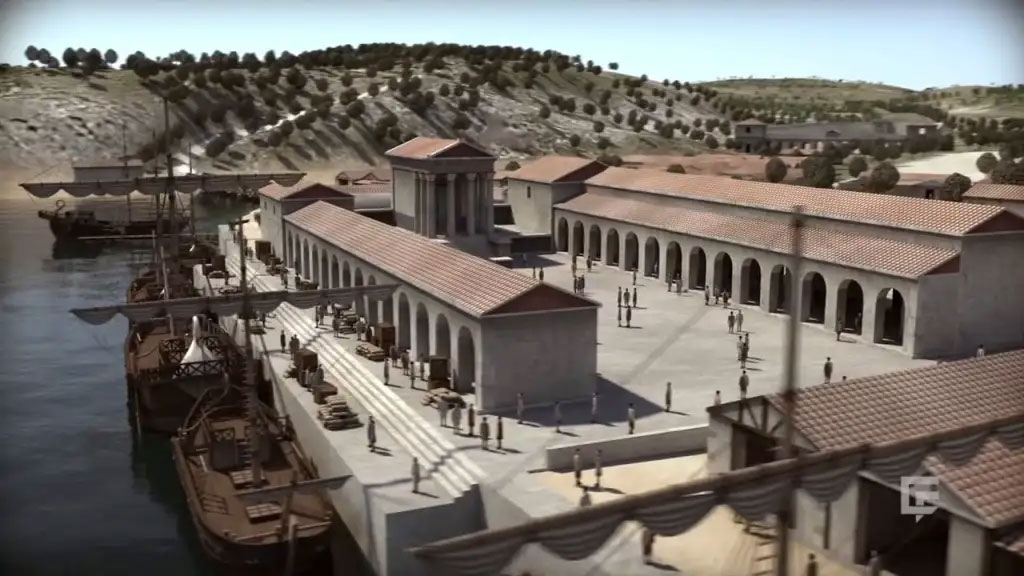
- Sources
- - https://lisboaromana.pt/
- - Felicitas Iulia Olisipo, mais do que uma cidade entre o Mediterrâneo e o Atlântico - CARLOS FABIÃO
- - Importação e exportação de produtos alimentares em Olisipo: as ânforas romanas da Rua dos Bacalhoeiros - VICTOR FILIPE
- - Cities of Roman Hispania - Felicitas Ivlia Olisipo - CARLOS FABIÃO
Notes- 1: The people who lived there were called Arotrebae. V2.5
- 2: Plinius the Elder – Naturalis historia (Plin. Nat. IV.35)
- 3: Strabo 63 BC. – 23 AD.
- 4: Found at the archaeological excavation in the old Sommer warehouses, in Alfama © CML DMC DPC CAL Guilherme Cardoso 2017
- 5: Read https://www.romanports.org/en/articles/human-interest/280-imitatio-et-aemulatio-2.html
- 6: Read https://www.romanports.org/en/articles/ports-in-focus/698-tyre-birthplace-of-europe.html
- 7: Esturarium is a widened, mostly funnel-shaped mouth of a river.
- 8: Strabo, Geographika III, 3, 1
- 9: RGDA, 26 (Res Gestae Divi Augusti)
- 10: autopanegyric – a formal public speech consisting of uncritical self-glorification
- 11: Nat. 2, 167
- 12: Sons and daughters of Poseidon (Greek mythology)
- 13: Nat. 9,9
- 14: Publius Cornelius Tacitus (ca. 56-117)
- 15: Painting Harry Payne
- 16: Suetonis (Suet. V, 17).
- 17: Photo - https://galiwonders.com/
- 18: During the construction of an underground car park at the current Praça de D. Luiz, part of the ancient riverbed, littered with material from the Roman period, was found.
- 19: Photo credits: Era, Archeologie
- 20: Museu Nacional Arqueològic de Tarragona (Dottsa Pilar Sada) Photo: David Williams
- 21: Cabotage - When a carrier from one country transports goods between 2 points within the borders of another country.
- 22: Photo - Millennium BCP Foundation | NARC
- 23: Photo: Centro de Arqueologia de Almada Ecomuseu Municipal do Seixal 1990
- 24: Nat.15.17
- 25: The word republic is derived from the Latin term ‘ Res Publica’
- 26: Photo-Pinterest (Mark Beerdom)
- 27: Magna Mater – here the goddess Cybele (aka Isis)
- 28: Archive of Cenáculo, kept in the Évora Public Library.
- 29: Ribeiro, 1994
- 30: Asclepius, according to Greek mythology, was the demigod of medicine and healing






 We are committed to providing versions of our articles and interviews in several languages, but our first language is English.
We are committed to providing versions of our articles and interviews in several languages, but our first language is English.